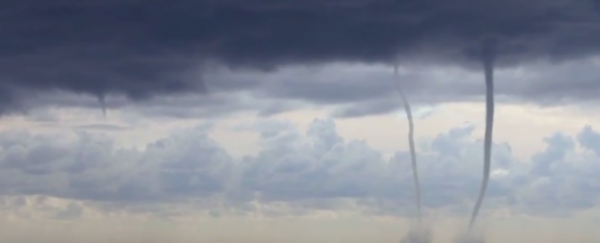
It hardly looks real, but this is what freelance illustrator Nicola Ferrarese saw when he looked out of his hotel in San Bartolomeo al Mare, Italy. Waterspouts are spinning columns of air and water mist, and can either form during fair weather, or severe, storm and tornado weather.
Tornadic waterspouts are the ones you need to watch out for - they're basically identical to land tornadoes, except that they form over water, which means they're extremely dangerous. They form in the middle of a severe thunderstorm, as the air rises and rotates on a vertical axis to form a whirling, elongated column. Tornadic waterspouts are often paired with high seas, fat hail, and frequent lightning, National Geographic calling them "the most powerful and destructive type of waterspout".
Fair-weather waterspouts, on the other hand, are much more common and very rarely dangerous. They form under slow-moving cumulus clouds, so they often don't travel very far, and are associated with developing storms. Working their way up from the sea to the sky, fair-weather waterspouts only have lifespans of about 20 minutes, and will have disappeared once the storm has set in. The ones in the footage above are likely to be fair-weather waterspouts.
According to National Geographic, because waterspouts need a lot of humidity and warm air temperature to form, they're most common in tropical and subtropical areas around the world, including the Florida Keys - they reportedly experience 400 or so waterspouts every year - the Greek islands, and off the east coast of Australia.
Either that, or they're just drunk Dali elephants, as one of the readers at SPLOID pointed out:
 Credit: Salvador Dali
Credit: Salvador Dali
Sources: SPLOID, National Geographic
